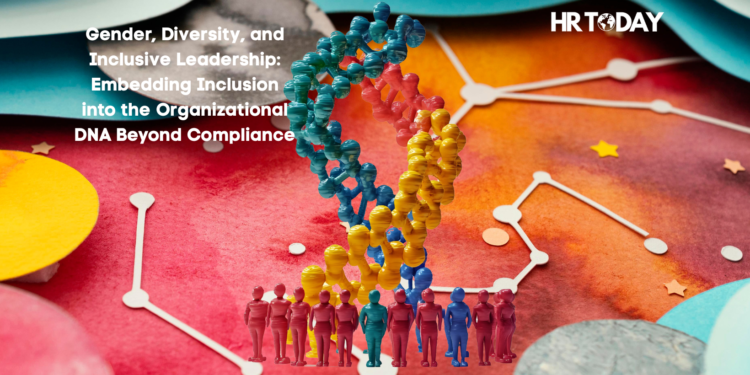The Idea in Brief
The context: Disruption has become the new normal. Organizations face rapid technological shifts, evolving workforce expectations, and global demands for agility and resilience.
The imperative: Gender, diversity, equity, inclusion, and belonging (DEIB) can no longer be treated as compliance obligations. They are now central to organizational sustainability, innovation, and long-term value creation.
The challenge: Policies alone are insufficient. Without embedding inclusion into culture and systems, organizations risk disengagement, attrition, and the inability to attract or retain top talent.
The opportunity: Leaders who embed DEIB into organizational DNA—through inclusive leadership, sponsorship, and system redesign—transform workplaces into resilient, innovative, and high-performing cultures where belonging drives long-term success.
Beyond Compliance: Embedding DEIB into Organizational DNA
Disruption today demands more than operational excellence. Leaders must demonstrate clarity of purpose, steadiness of values, and intentional action. In this reality, gender, diversity, and inclusive leadership are not optional; they are strategic imperatives.
Employees increasingly expect fairness, equity, and respect for diverse perspectives. When organizations treat inclusion as a compliance box, they miss the opportunity to harness it as a driver of innovation and resilience. Embedding DEIB into culture reshapes how power, decision-making, and opportunity flow—ensuring that inclusion is lived daily, not just written in policy.
The shift is clear: leaders must stop asking whether diversity policies exist and start asking whether employees experience them consistently, authentically, and meaningfully.
Representation, Experience, and the Power of Inclusive Leadership
Despite women constituting nearly half the global workforce, only 28% of senior leadership roles are held by women, with representation dropping sharply at the C-suite level (McKinsey, 2023). Diversity extends far beyond gender to include race, ethnicity, socio-economic background, cognitive styles, disability, and more.
Inclusive leadership is the lever that turns representation into impact. Research shows that while most companies have formal diversity programs, only 28% of employees feel fully included (Center for Talent Innovation). The gap is stark: policies exist, but experience lags.
Inclusive leadership bridges this gap through deliberate behaviors:
- Active listening and bias recognition
- Encouraging diverse perspectives
- Creating psychological safety
- Holding oneself accountable for lived employee experience
These actions improve retention (by up to 40% among underrepresented groups, HBR), enhance collaboration, and strengthen resilience. Crucially, DEIB must be woven into strategic decision-making—from M&A to innovation pipelines—so it shapes outcomes, not just HR processes.
Beyond Mentorship: Sponsorship as a Catalyst
Mentorship builds skills and confidence, but mentorship alone rarely dismantles systemic barriers. The critical differentiator is sponsorship—leaders using influence to actively advocate for underrepresented talent, creating visibility and access to opportunities.
Sponsorship changes the system, not just the individual. It ensures that high-potential employees are seen, supported, and promoted into leadership tracks. Unlike mentoring, sponsorship shifts conditions of advancement by opening doors to high-impact projects and decision-making forums.
For DEIB, sponsorship is vital: structural inequities often deny underrepresented groups the informal networks of influence. Sponsorship corrects this imbalance by making advocacy a leadership accountability, not a discretionary act.
When leaders extend sponsorship to systemic interventions—challenging biased evaluation criteria, redesigning succession planning, and diversifying talent pipelines—the impact becomes transformative.
Building Sponsorship into DEIB Strategy
Organizations can embed sponsorship systematically by:
- Formalizing sponsorship programs: Pair diverse high-potential talent with senior leaders accountable for advocacy.
- Embedding sponsorship in KPIs: Hold leaders responsible for sponsoring diverse talent alongside business outcomes.
- Creating visibility platforms: Showcase underrepresented employees through stretch assignments and speaking opportunities.
- Measuring progress: Track sponsored employees’ career trajectories to gauge structural impact.
- Normalizing through storytelling: Leaders should openly credit sponsorship in their own journeys, embedding it into cultural expectations.
When structured, measured, and normalized, sponsorship becomes a strategic lever for DEIB rather than an informal, optional act.
Embedding Inclusion into Culture and Systems
Diversity is representation; inclusion is experience. Organizations embed inclusion when daily behaviors—how work is assigned, contributions recognized, and decisions made—reflect fairness and respect.
Smaller companies benefit as much as large enterprises. Inclusive leadership enhances agility, decision-making, and engagement. Leaders can embed inclusion directly into operations, making it integral from the outset.
Systems also matter. Recruitment, performance management, promotions, and succession planning must be viewed through an inclusion lens. Transparent and bias-free processes institutionalize inclusion and align it with organizational purpose.
The shift is from “program-based” inclusion (measured by trainings and policies) to “experience-based” inclusion (measured by lived employee perception: Do I feel safe to speak up? Are career pathways transparent?). This redefines inclusion as a daily lived reality rather than symbolic gestures.
Blending Mentorship and Sponsorship: Practical Examples
At VDart, programs such as the Global Women’s Leadership Initiative (GWLI) combine mentorship and sponsorship to accelerate women’s leadership journeys.
- Mentorship builds skills and confidence.
- Sponsorship ensures talented employees access high-visibility opportunities that influence outcomes.
Initiatives like Thinnai champion belonging by creating spaces where women’s voices are amplified and a culture of sisterhood is built through compassion and independent, purpose-driven initiatives.
Other forums and skill-building initiatives reinforce inclusion by creating safe spaces for dialogue and development. Together, these programs illustrate how DEIB becomes lived culture, not policy statements.
Read Also : When HR “Produces Nothing”: A Response to Jennifer Sey’s Anti-HR Vision
The Fine Balance: Navigating Work, Life, and Mental Wellbeing
Mind the Leadership Gap – From Learning to Real-World Impact
How the Adecco Group is empowering its employees for the future of work











